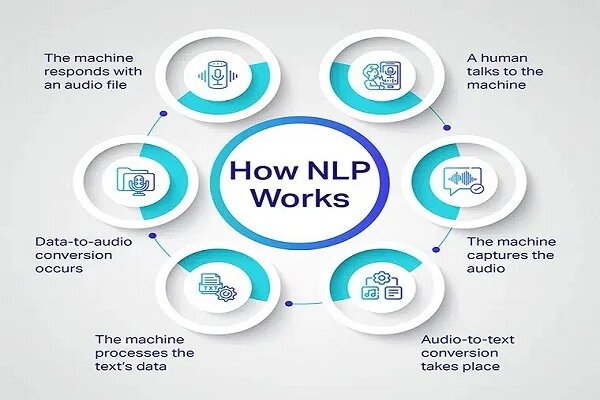What is NLP (Natural Language Processing)
NLP or natural language processing is a process of helping machines to understand and react to human language by giving helpful answers. In the present-day world, the digital material is expanding and Natural Language Processing Development services uses this textual data. It helps to perform data analysis, manage content, and help users with customer service. Understanding NLP is helpful in how we live and use technology by bridging the gap between human language and machine understanding.
How NLP (Natural Language Processing) Works?

Natural language processing has important steps:
- First it starts with organizing and cleaning data by removing errors, stop words, and punctuations.
- Next the document is broken into smaller words or phrases; known as chunks.
- It then identifies nouns, verbs, and adjectives as a part-of-speech process.
- It also identifies particular persons, locations, and organizations in the given text.
- It also identifies the text’s sentiments i.e. neutral, negative, or positive.
- Lastly it translates the text between different languages.
Usage of NLP
NLP services offers many real-world applications such as:
- Virtual assistants like Alexa, Siri, and Google Assistant depend on nlp to process the spoken commands.
- Customer support or sales queries chatbots.
- Google search engine uses natural language processing to understand user queries and provide relevant search results.
- Google translator provides real-time language translation capability by using the NLP algorithms.
- Understanding NLP helps to generate summaries from large documents thus saving human time and effort.
- NLP helps to monitor social media insights to identify public sentiments on hot or trending topics.
Challenges in Natural Language Processing
Above all benefits, NLP has certain disadvantages:
- The meaning of words and phrases can be changed based on context.
- Handling idioms and slang is complex due to their cultural context.
- Biased training data can lead to prejudiced NLP models.
- Different dialects and evolving language usage pose difficulties.
The Future of Natural Language Processing (NLP)
Understanding NLP future offers exciting opportunities. Key trends include:
- Better Multilingual Support: Improved language models will support more languages and dialects.
- Contextual Understanding: Models will become better at understanding nuanced human conversations.
- Personalized Interactions: NLP-powered systems will offer more tailored and context-aware user experiences.
- Healthcare Applications: NLP will play a vital role in medical research, diagnostics, and patient care.
Example of NLP
The below code example uses NLTK to tokenize a sentence into words, known as tokens, and print the tokens on the IDE console.
import nltk
from nltk.tokenize import word_tokenize
# Example text
text = "Natural Language Processing is fascinating!"
# Tokenize the text
tokens = word_tokenize(text)
# Print tokens
print(tokens)
Conclusion
NLP is used to transform the way we interact with technology. By understanding NLP helps to change digital lives and makes communication with machines initiative and human-like.

